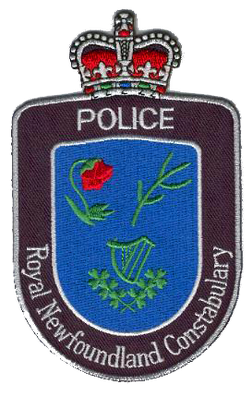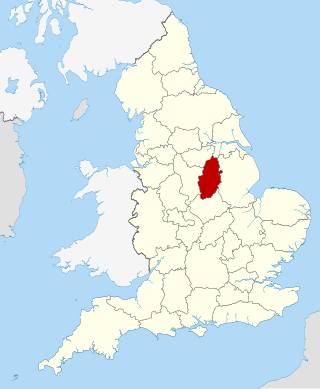Related Research Articles

The Royal Irish Constabulary was the police force in Ireland from 1822 until 1922, when all of the island was part of the United Kingdom. A separate civic police force, the unarmed Dublin Metropolitan Police (DMP), patrolled the capital and parts of County Wicklow, while the cities of Derry and Belfast, originally with their own police forces, later had special divisions within the RIC. For most of its history, the ethnic and religious makeup of the RIC broadly matched that of the Irish population, although Anglo-Irish Protestants were overrepresented among its senior officers.

The Royal Newfoundland Constabulary (RNC) is the provincial police service for the province of Newfoundland and Labrador.

Nottinghamshire Police is the territorial police force responsible for policing the shire county of Nottinghamshire and the unitary authority of Nottingham in the East Midlands area of England. The area has a population of just over 1 million.
Sir George Morley was a British police officer.
Sir Harry Philip Parnell Lane was a British police officer who served as Chief Constable of Lancashire Constabulary from April 1912 until his death in 1927.
Captain Athelstan Horn Popkess was Chief Constable of Nottingham City Police from 1930 to 1959 and as a result of his transformations in modernising policing could be considered the twentieth century's greatest police officer in the UK according to a 2020 biography. He achieved particular notoriety following an investigation into corruption in Nottingham City Council in an incident which became known as "The Popkess Affair" due to the false suspicion that he had leaked information.
The New Year Honours were appointments by King George V to various orders and honours to reward and highlight good works by citizens of the United Kingdom and British Empire. They were announced on 31 December 1926.
The New Year Honours 1914 were appointments by King George V to various orders and honours to reward and highlight good works by members of the British Empire. They were announced on 2 January 1914.
The New Year Honours 1923 were appointments by King George V to various orders and honours to reward and highlight good works by members of the British Empire. They were published on 29 December 1922.
The 1924 New Year Honours were appointments by King George V to various orders and honours to reward and highlight good works by members of the British Empire. They were published in The London Gazette on 1 January 1924.
The New Year Honours 1925 were appointments by King George V to various orders and honours to reward and highlight good works by members of the British Empire. They were published on 30 December 1924.
The New Year Honours 1922 were appointments by King George V to various orders and honours to reward and highlight good works by members of the British Empire. They were published on 30 December 1921.
The New Year Honours 1920 were appointments by King George V to various orders and honours to reward and highlight good works by members of the British Empire. They were published on 1 January 1920 and 30 March 1920.
The 1929 New Year Honours were appointments by King George V to various orders and honours to reward and highlight good works by citizens of the United Kingdom and British Empire. They were announced on 26 February 1929. The announcement of the list was delayed two months by the health of the king, who fell ill with septicaemia in November 1928. There were no recipients of the Royal Victorian Order and only two recipients in the military division of the Order of the British Empire.
The 1932 New Year Honours were appointments by King George V to various orders and honours to reward and highlight good works by citizens of the United Kingdom and British Empire. They were announced on 29 December 1931.
The 1933 New Year Honours were appointments by King George V to various orders and honours to reward and highlight good works by citizens of the United Kingdom and British Empire. They were announced on 30 December 1932.
The 1935 New Year Honours were appointments by King George V to various orders and honours to reward and highlight good works by citizens of the United Kingdom and British Empire. They were announced on the 28 of December, 1934.
The 1924 Birthday Honours were appointments by King George V to various orders and honours to reward and highlight good works by citizens of the British Empire. The appointments were made to celebrate the official birthday of The King, and were published in The London Gazette on 3 June 1924.
Sir Colin Sampson, was a British police officer who held several senior police posts in the last decades of the 20th century.
Nottingham City Police, originally founded as the Borough of Nottingham Police, was a UK police force created under the Municipal Corporations Act 1835 in the style of Robert Peel's Metropolitan Police which initially launched in 1836. This initial force failed and was re-founded successfully in 1841. It had responsibility for law enforcement within the geographic area as defined by the boundaries of the city of Nottingham. Under the Police Act 1964 the force was compulsorily amalgamated with Nottinghamshire County Police to form the Nottinghamshire Combined Constabulary, now re-named Nottinghamshire Police.
References
- ↑ University of Nottingham, East Midland Special Collections Archive, Pl E12/6/19/40/1-6 'Bundle of papers relating to a lease of Grove House in Brunt Street, Mansfield, Nottinghamshire, from the 6th Duke of Portland to William H. Tomasson; 1882-1887'
- ↑ "Sherwood Historial Timeline". www.woodthorpefriends.co.uk. Retrieved 2024-07-29.
- ↑ "Anglo-Boer War | Unit Information | Baker's Horse". angloboerwar.com. Retrieved 2024-07-29.
- 1 2 "Chancery of the Royal Victorian Order". The London Gazette. 1906-10-23. p. 7108. Retrieved 2024-07-29.
- ↑ Tomasson, William H (2012). With the Irregulars in the Transvaal and Zululand: The Experiences of an Officer of Baker*s Horse in the Kaffir and Zulu Wars 1878-79. Leonaur. ISBN 978-0857067982.
- ↑ "Tomasson and Dymond family". www.brierleyyorkshireengland.net. Retrieved 2024-07-29.
- ↑ Stallion M, Wall DS (2012). The British Police: Forces and their Chief Officers 1829-2012 (2nd ed.). Hook, Hampshire: The Police History Society.